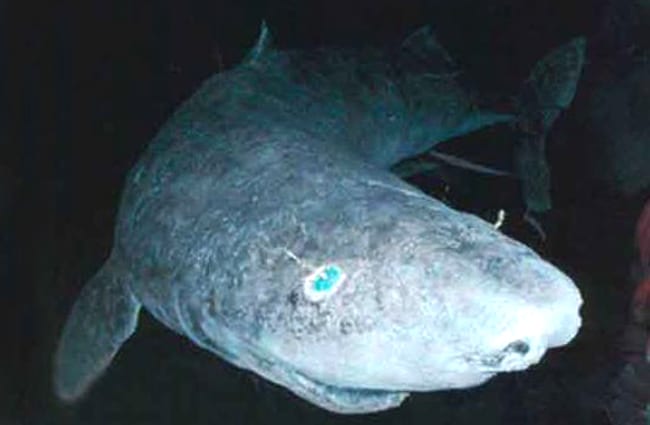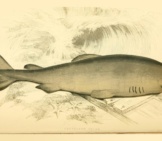Greenland sharks are cold-water species that can grow to impressive lengths. While they fail to rival the filter feeding whale shark and basking shark, both of which can measure over 40 ft. long, these sharks are some of the largest carnivorous species. These sharks can grow up to 23 ft. long, a few feet longer than the largest great white shark. Read on to learn about the Greenland shark.
Description of the Greenland Shark
The largest recorded specimens of this species weighed in at over 2,000 lbs., and could potentially weigh over 3,000 lbs. at their max! They have dark colored skin, and broad bodies. Both their dorsal fin, on their back, and their pectoral fins, on their sides, are quite small in comparison to their bodies. They have a blunt, rounded snouts and very small eyes.
Interesting Facts About the Greenland Shark
sGreenland sharks are incredibly interesting creatures, albeit not particularly beautiful or graceful. They have a number of adaptations related to living in frigid polar regions.
- Perpetual Growth – Scientists believe that these sharks continue to grow throughout their life. Researchers studying Greenland sharks found that the largest individuals were also the oldest individuals, which means that they keep growing throughout their life.
- Longest Lived Vertebrates – Scientists using radiocarbon dating of the crystals within the eyes of Greenland sharks estimate that the largest (and thus oldest) individuals could be between 272 and 512 years old, making them the longest-lived vertebrates on earth!
- Polar Trends – They aren’t the only ancient creatures roaming the polar seas. Bowhead whales live in the same arctic and sub-arctic regions, and have been confirmed to live at least 200 years. Those are some old animals!
- Secretive Swimmers – These large, slow-moving sharks are actually surprisingly little known. It can be quite difficult to study creatures in their natural habitat when they live in freezing cold waters deep below the surface of the ice. Scientists hadn’t even recorded photos of Greenland sharks in their natural habitat until 1995, and didn’t record video until 2003.
Habitat of the Greenland Shark
These sharks migrate between the shallow waters of river mouths and bays, and the depths of the Arctic Ocean. During the winter, they move inland to seek warmer waters, and during the summer they move into deeper waters. They usually remain around 1,500 ft. deep, but have been found much deeper. Waters at this depth can be as cold as 28º F.
Distribution of the Greenland Shark
Greenland sharks live in the arctic and sub-arctic zones of the northern Atlantic. They can be found off the coasts of Greenland, Europe, and Canada. Their range typically hugs the coasts of landmasses, and extends some ways off shore. Generally speaking, they are not found at extreme distances from shore.
Diet of the Greenland Shark
This species is incredibly opportunistic, and will feed on just about anything it can get its teeth into. They will feed on live prey, including smaller species of sharks, flounder, cod, herring, capelin, lumpfish, eels, wolf fish, and skates. It is also common for them to eat carrion, and the remains of seals, polar bears, whales, reindeer, horses, moose, and more, have been found within their stomachs.
Greenland Shark and Human Interaction
Because of their unforgiving natural habitat, these sharks do not interact with humans frequently. If you come in contact with a Greenland shark while swimming hypothermia is probably higher on your list of concerns than the shark is. They do, however, commonly become entangled in fishing nets as bycatch.
Though researchers do not have extensive information on their population numbers, because they are frequently captured accidentally, and they reach sexual maturity extremely slow (possibly as late as 150 years old), these sharks are listed as Near Threatened by the IUCN Red List.
Domestication
Greenland sharks have not been domesticated in any way.
Does the Greenland Shark Make a Good Pet
Honestly, if you can provide cold enough temperatures, replicate their natural environment, and provide a large enough tank to house a shark that can potentially grow to be 23 ft. long… knock yourself out. Otherwise, these creatures do not make good pets.
Greenland Shark Care
Little is known about what it takes to care for these creatures in a zoological setting. In fact, little is known about these creatures in general! They would have to be kept at temperatures similar to their natural habitat, and removal from the deep sea would require lengthy allowances of pressure adjustment. To date, no Greenland sharks have been successfully kept in human care.
Behavior of the Greenland Shark
Very little is known about the everyday behavior of these creatures. This species, like their close relatives the sleeper sharks, are incredibly slow moving. Their average speed creeps along at less than 1 mph, and their fastest sustained speed is a miniscule 1.6 mph. They do swim faster in bursts while hunting, but hunting behavior has never been observed before. Scientists believe that these sharks may hunt via ambush, as their top speed is much slower than some of their prey.
Reproduction of the Greenland Shark
Scientists know that this species is ovoviviparous, which means that they develop the eggs within their bodies until they hatch, and then give “live birth.” The average litter consists of ten pups between 1 and 1.5 feet long. The gestation period of this species is unknown.
Because very little is known about these creatures, as research is quite difficult, little is known about the reproduction of this species. Most research is conducted on deceased specimens that are captured as bycatch.
Beliefs, Superstitions, and Phobias About the Greenland Shark
Native people in Iceland consider Greenland shark meat to be a delicacy. This can be somewhat tricky, as these sharks have extremely high levels of trimethylamine oxide (TMAO) in their meat, which can cause impairment. To combat this, the native people bury the meat for two months, and dry it for an additional few months, before consuming it.
In addition to TMAO, these sharks also have high urea content in their flesh. This high urea content is part of the folktale pertaining to the creation of Skalugsuak, the first Greenland shark. Legend has it, an old woman would wash her hair in urine, and dry her hair with a cloth. One day the cloth blew into the ocean, and became Skalugsuak.







![Red Angus Closeup of a beautiful Red Angus cowPhoto by: U.S. Department of Agriculture [pubic domain]https://creativecommons.org/licenses/by/2.0/](https://animals.net/wp-content/uploads/2020/03/Red-Angus-4-238x178.jpg)












![Red Angus Closeup of a beautiful Red Angus cowPhoto by: U.S. Department of Agriculture [pubic domain]https://creativecommons.org/licenses/by/2.0/](https://animals.net/wp-content/uploads/2020/03/Red-Angus-4-100x75.jpg)

